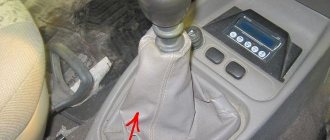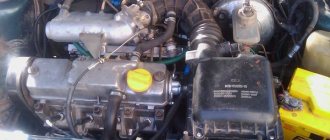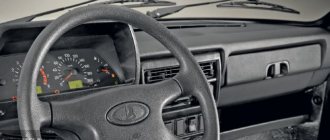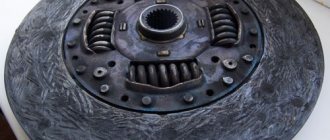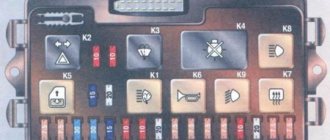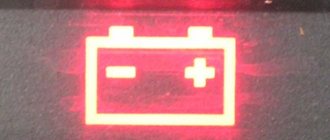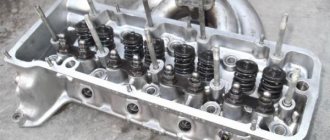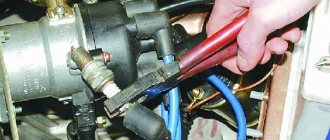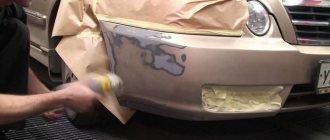What is "failure"? This is an effect in which the car does not accelerate when you press the gas pedal. Usually the failure lasts a few seconds, and then the “jerk” effect occurs. This is a fairly common malfunction associated with the fuel injection system. On Kalina, it does not occur often, but it does happen.
Video about gas failures on an injection engine:
This video material will talk about such a malfunction as gas leaks, the causes of occurrence, methods of elimination, and also contains some recommendations for car owners.
Causes of the phenomenon
Drop in speed and failure of the gas pedal
There are few reasons for the phenomenon of “failure” when pressing the gas pedal. It often appears after unsuccessful engine chip tuning and is accompanied by an increase in fuel consumption, but there are other problems directly with injection. So, let’s look at the main reasons for the “failure” effect:
- Injectors . The fuel distribution system directly affects engine performance.
Identifying and eliminating ECU errors
Condition of the candles. On the left the mixture is too rich, on the right it is too lean.
These are all the main reasons that can lead to gas pedal failure.
Dips during acceleration
Once the causes are considered, we can consider how to deal with the problem. So, let’s describe step by step what needs to be done when the gas pedal has dips during acceleration:
- The first step is to check the spark plugs. The appearance of carbon deposits or spark plugs that are too clean indicate that the mixture is not adjusted correctly. It is worth adjusting the correct amount of fuel mixture.
- Ignition wires can also cause the vehicle to malfunction.
- A clogged throttle can lead to failures during acceleration.
- The condition of the air filter affects the formation of the mixture, so it is worth changing it on time.
Air filter clogged
Dirty fuel filter
Dirty fuel filter
- ECU errors can also lead to accelerator failures.
- The last reason is clogged injectors. They need to carry out diagnostics, check functionality, and also clean and replace faulty elements.
Thus, the causes of failures during overclocking have been identified and can be eliminated.
Gas leaks at idle
At idle, there are fewer reasons for failures, but they will have to be eliminated, since the car simply will not start normally, or stall after starting the engine. So, let's look at the work plan step by step:
- Checking the spark plugs. If the element fails, it is necessary to replace it.
Attention! It is recommended to change all four spark plugs to ensure smooth engine operation. Before installation, you should adjust the gap using a feeler gauge, which should be 1 mm for 92 gasoline.
Checking and adjusting the spark plug gap using a feeler gauge
- We change the fuel filter, it is located under the bottom of the tank, and also carry out diagnostics on the fuel pump. If malfunctions are identified, they should be eliminated.
Clogged filter in the gasoline pump
All these reasons can cause dips to appear at idle (more precisely, when switching from idle to driving mode).
Expert answer
The following two tabs change content below.
- About the expert:
Frets Expert
An expert on Lada cars with many years of experience. I own a Lada Granta car, I collect cramps based on the Priora. Sometimes I stay overnight in the garage. My wife is more jealous of cars than of women.
I can assume that due to power surges, the engine control system “glitched” and went into emergency mode. It’s a pity that we didn’t look at the error code, but most likely the error was: “ Low signal level of the gas pedal sensor .”
In this case, you did everything right. We found a box in which it does not rain and removed the battery.
Removing a battery terminal in heavy rain is dangerous; the battery may short out and explode! Yes, this is not a joke, batteries explode!
If you have a similar situation when the engine does not respond to the gas pedal and an error appears on the instrument panel screen, then try the following:
- turn on the ignition and sharply press the gas pedal all the way several times.
Press the gas pedal all the way down
- Start the car, if it idles steadily, then again sharply press the gas pedal all the way.
- Next to the pedal there is a so-called “frog” - this is the contact block with the wires. Move it, take it off and put it on again (just before doing this, remove the terminal from the battery).
- The brake pedal frog could also be stuck.
This is easy to check; if this happens, the rear brake lights should be on. The brake pedal may also squeak when driving. This is what the brake pedal frog looks like
Detailed video about removing the frog pedal
If all else fails, then you need to contact the dealer or an experienced diagnostician. Most likely, your ECU (electronic control unit of the car) has been flooded with water, or a short hole has appeared in the area from the pedal assembly to the rear dimensions. Or the electronic gas pedal could even break down.
Read more about where the ECU is located on the Lada Granta here!
One of the symptoms of a faulty frog (pedal limit switch) is failures during acceleration, but failures can also be caused by a clogged fuel filter.
conclusions
The main cause of failures are spark plugs, but they are not the only ones that influence the appearance of this effect. Some car enthusiasts may not be able to cope with the occurrence of such malfunctions on their own, and it is necessary to go to a car service center, where they will carry out high-quality diagnostics and also fix the problem. But it is worth considering that you will have to be generous, since neither computer diagnostics nor repairs will cost a penny.
Sometimes motorists are faced with such an infrequent, but extremely unpleasant phenomenon as failures when pressing the gas pedal on the injector of a VAZ 2114. In short, such failures are the lack of a quick response from the car engine to pressing the gas pedal. We will talk about why they can arise and how to eliminate them on your own in today’s article.
Dips when pressing the gas pedal - carburetor
As noted above, the problem occurs in VAZ 2107, 2106, 2109 cars that have a carburetor installed. Mainly problems with the fuel system . It will most likely be clogged. Therefore, to identify the cause, the fuel supply to the carburetor is checked.
As a result of clogging, the operation of the fuel pump decreases, and the carburetor begins to receive less fuel. As a result, the engine starts and idles without problems, but when pressed, failures occur.
Contact qualified specialists. With us you can choose a car service that is closer to you and ask for help. They will help you with your problem.
If everything is fine with the fuel system, then the fault must be looked for in the carburetor. It is responsible for dosing the supplied fuel into the air flow. If there are violations, failure occurs. However, first you need to check for air leaks . The carburetor may become loose, allowing air to leak through the gap, making the mixture lean.
The filter mesh must also be checked. It is located in the inlet fitting of the pipeline that goes to the fuel pump. If it is contaminated, then this is a consequence of failures.
Dips when pressing the gas pedal on the carburetor:
Features of failures
What all pedal failures have in common is that when you press the pedal, the engine does not respond in a timely manner, and therefore does not gain momentum. Such failures can appear in different situations and the behavior of the machine can also be different.
So, we can highlight:
- Short dips while driving (no more than a couple of seconds) followed by a quick response from the engine.
- Dips during acceleration.
- Dips at idle speed.
- Prolonged failures, as a result of which the car stalls.
- Jerking, characterized by a series of alternating short dips and subsequent jerks.
There are not many reasons for this phenomenon, so finding and eliminating them will not be difficult for an experienced driver.
In 99% of cases, failures can be caused by one of the following reasons:
If you notice even minor changes in the “behavior” of the engine, you should end the trip as quickly as possible and visit a car service center or perform independent diagnostics and repairs. Continuing to drive a car with dips is not only harmful to the car itself, but also extremely dangerous.
Why does the car jerk?
There can be simply a huge number of problems due to which a car can drive jerkily (twitch), and they are individual for each car. These could be problems with the fuel system or transmission problems. Let's look at each of the reasons.
Fuel problems
Problems related to fuel supply to the engine.
Gasoline pump
All cars with injection engines are equipped with a fuel pump that pumps pressure into the fuel system. The normal operating pressure of the pump reaches 10 kg/cm³. Over time, the pump may lose its former power due to aging or dirty filters, fine and coarse fuel cleaning, which will undoubtedly lead to a loss of pressure and improper operation of the internal combustion engine.
Injectors
Another important indicator in the fuel system is the injectors. They spray fuel into the engine cylinder head, mixing it with air and feeding it into the combustion chamber. Over time, the injector nozzle becomes clogged with dirt and carbon deposits, which contributes to incorrect and even insufficient fuel atomization, which leads to uneven operation of the entire internal combustion engine.
Ignition problems
Problems associated with the formation of a spark in the engine.
Candles
To ignite the fuel mixture in a car, spark plugs are used, which produce sparks in the combustion chamber, thereby igniting the air-fuel mixture. Over time, due to the low quality of fuel, which is abundant in the vast expanses of the Russian Federation, spark plugs become covered with soot or, due to exposure to high temperatures, change their gap, which leads to improper operation of the internal combustion engine.
Wires
Spark plug wires also play an important role in engine operation; they transmit high voltage from the coil to the spark plug. The insulation of these wires is made of silicone and, under the influence of high temperatures and time, is subject to drying out and, consequently, cracks. High voltage, passing through a wire with a crack, can make its way to the body and thus does not even reach the spark plug, this is especially noticeable at high speeds and when the car is running under load.
Reels
The ignition module is the element that produces a spark to the cylinders; when it fails, the cylinders fail, but it often happens that the module can turn off due to temperature or load. By the way, the ignition module is no longer available in more modern cars; it was replaced by individual ignition coils, which helped get rid of wires and their problems. The IKZ is put directly on the spark plug and produces a spark for exactly one cylinder in which it is installed.
Dips during acceleration
Most often, in the VAZ 2114 car, failures when pressing the gas injector occur during acceleration.
If you are faced with a similar situation, then the search for its problem should be carried out in the following sequence:
- If the spark plugs are oxidized or covered with soot, they should be cleaned with a cloth with kerosene or fine sandpaper (or replaced if they cannot be restored). In addition, the composition of the fuel mixture should be adjusted, since very often the cause of soot on the spark plugs is precisely its incorrect composition.
If on your VAZ 2114 failures occur when you press the gas injector while driving, then using the above plan you can easily find the causes of this phenomenon and be able to eliminate it.
How to Avoid Failures
Having talked about how to eliminate gas pedal failures that occur on a car, it is worth talking about how to completely avoid their occurrence. So, the most common cause of their occurrence is wear of the spark plugs. Therefore, you should always check their condition, prevent clogging and oxidation, and, if necessary, replace them.
It is worth remembering that it is highly recommended to replace spark plugs as a “set”, even if only one of them is seriously damaged.
In addition to spark plugs, high-voltage wires should also be periodically monitored (despite the fact that they have a long service life, core breaks and breakdowns of protection are far from uncommon).
Another very common cause is clogged filters, and especially the air filter. This element is a direct participant in the chain of formation of the working mixture, and that is why its contamination (or even damage) can immediately affect the operation of the engine.
The last thing you should pay attention to in order to avoid unpleasant gas failures is the quality of the fuel. If you notice that at the nearest gas station it has dropped significantly (and the car reacts to this), then you should not continue to use it - it is better to try refueling at a pump of another company (or several companies). In this way, you can find the highest quality gas station and ensure reliable operation of your car’s engine.
Failure is always bad, no matter in what context this word is said. In the case of the gas (accelerator) pedal, this is also unpleasant, moreover, it is dangerous, because instead of sharp acceleration, the driver gets a dip and complete inactivity of the engine. As you understand, at speed, during overtaking, this phenomenon can end badly...
As I already said, failures when pressing the gas pedal are the lack of response of the engine to pressing the gas pedal, that is, you pressed the pedal, but there is no acceleration. As a rule, the pickup still occurs, but with a delay; moreover, the response can manifest itself in the form of a sharp push or jerk, which also does not bring anything good. For example, on a slippery road, a jerk can result in loss of control or lead to an accident.
Such a malfunction is usually associated with the fuel system, but there may be other reasons why failures occur when pressing the gas.
Description of the problem
In general, there was a terrible downpour, puddles on the roads, and general floods in the yards.
Heavy rain could affect the operation of the car's electronic systems
But we had to go, my wife and daughter were in the shopping center, and the queue for the minibus, according to them, was huge. I am inclined to believe that the minibuses simply stalled (we have old, decrepit Gazelles in our city).
We have one place that is constantly flooded. I look, and there are new Kia Sid floating on the radiator grille in the water, well, I’m taller, I thought that nothing would happen. Here, as luck would have it, the traffic light is still red, and the intersection is straight, only a pedestrian crossing, on which there is no one at all, since it is knee-deep in water. Most people pass it, even on red lights, quietly. And I’ve only been driving for a month, I’m not used to breaking rules yet. Has stopped.
Belt whistled due to water ingress
My Granta is standing there, waiting for the green light, and then the alternator belt started whistling, as if it was slipping. I see the voltage on the on-board computer jumps, from 13 Volts to 11.8, and there is a whistle under the hood. The light turned green and I was off. I started, drove out of the puddle, accelerated a little and the whistle disappeared. The voltage on the on-board computer screen leveled out to 13.6.
Among the current consumers, my headlights were on, the rear window was heated, the tape recorder was working quietly, and the heater was turned on at second speed to blow the windshield.
I got to the shopping center, stopped, and waited for my wife and daughter. The engine begins to vibrate and bleed a little. I went home already on the detour, there are fewer puddles there. I dropped everyone off and decided to go to the garage.
I started the engine, the revolutions jumped to 6000, I was already scared. Then they dropped to 1000, the engine sneezed and died. The check engine light on the dashboard came on. It started again, it idles, but pressing the gas pedal does not respond. I try to start, it idles and doesn’t respond to the pedal at all when driving. So I drove to the garage in second gear, well the 21116 engine is torquey and drives like a tractor.
I repeated the experiment in the garage. I started it up, tried to press the gas pedal, nothing happened, the revs were like a glove, the engine icon was still on.
How I solved the problem of gas pedal failure
- I took a smoke break and decided to remove the terminal from the battery.
- I reset it and waited five minutes. He swore that he forgot the diagnostic adapter at home.
- Reconnected the terminal and started it.
- “Jackie Chan” stopped burning, the engine reacts to the gas pedal with a vigorous increase in speed. The engine really didn’t start at first, it started only the second time.
I left the garage, circled along the pit line, and came back. There were no signs of damage. Now I'm afraid to drive in the rain.
What could it be? Now I’m subconsciously afraid that if I start the engine, my Lada Granta won’t want to go anywhere in rainy weather. How likely is this situation to happen again?
